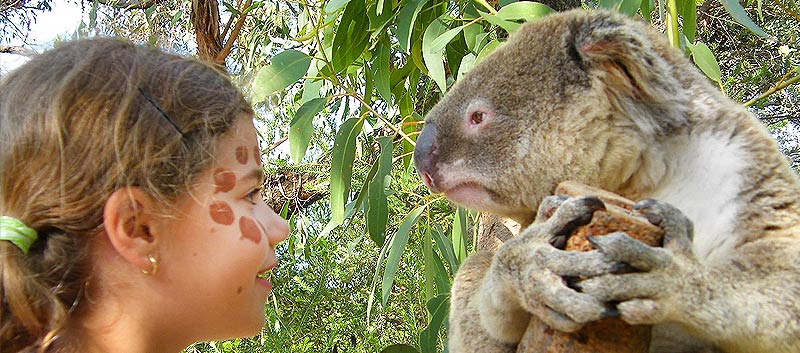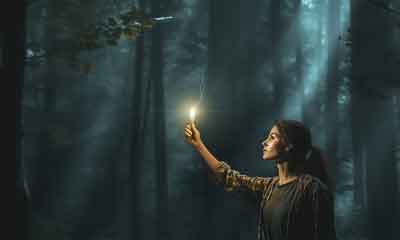
Do all visitors have to go on a tour?
No. You don’t have to go on a tour if you prefer not to. You can relax at the Visitor Centre where many of the free-ranging animals usually hang out, or you can wander around by yourself and see how many different animals you can spot. Or you can head out along the tracks to visit the Aboriginal sites.
However, we do recommend that you join in the ranger-led activities. The rangers are specialist guides who can explain the significance of the ancient Aboriginal heritage sites at the park, indulge your five senses in an interactive bush tucker and bush medicine experience, and help you get up close and personal with an amazing array of Australian animals.
How many animals are roaming freely at Walkabout Park?
Walkabout Park protects over 100 types of bird, such as the Superb Lyrebird, the Laughing Kookaburra and the uncommon Rock Warbler. There are more than 40 types of reptiles and frogs, from the Diamond Python to the Giant Goanna and the Eastern Froglet. It is hard for us to know exactly how many animals inhabit the sanctuary as many, especially birds, reptiles and some frogs, can come and go as they please.
However, we do have approximately 25 Eastern Grey Kangaroos, 20 Swamp Wallabies, 8 Emus, 20 Tamar Wallabies, 35 Red-Necked Pademelons, 16 Parma Wallabies, 40 Rufous Bettongs and many Bandicoots, along with the many other more secretive critters like Eastern Pygmy Possums and Sugar Gliders that we don’t have an exact number for, living free in the sanctuary.
Why are some animals kept in enclosures?
At Walkabout Wildlife Sanctuary, we don’t believe in keeping animals in cages to entertain our human visitors. We are not a traditional zoo. We are a working wildlife sanctuary! However, some animals need to be kept in purpose-built enclosures for their own and the other animals’ safety.
One specialised reason for enclosures is for those animals that are part of national ‘breed for release back into the wild’ programs, such as the Spot-tail Quolls, Bilbies, Tasmanian Devils, Brush-tail Rock Wallabies and Parma Wallabies. You will see our Koalas, Grey-headed Flying-foxes and Dingoes, as well as Ally and Wadu and Gundy the Wombats, and some of our reptiles, in enclosures in the Visitors’ Centre and along the Animal Loop Walk.
Are there snakes at Walkabout Park?
Yes, this is Australia. There are several species of snake at Walkabout Park. The most commonly seen is the Diamond Python, which is non-venomous. The more venomous species that inhabit the park, although not often seen, are the Red-Bellied Black Snake, Eastern Brown Snake, Tiger Snake and Death Adder. Other snakes we see from time to time include the Marsh Snake, Green Tree Snake and the Bandy-Bandy.
Because of their shy, secretive natures, and also because they go into torpor or hibernate (or “brumate”) during the cooler months emerging around September, wild snakes are rarely seen. If you do see a snake, stand absolutely still until the snake passes, or if it is resting peacefully then move slowly away from the snake. It is a thrilling experience to be able to see a snake in the wild – a privilege that very few people get in their lifetime as these animals are such elusive creatures.
If you’d like a chance to meet a snake, visit Neil the Diamond Python, our Rainbow Serpent the Olive Python, and their other scaly friends in our Visitors’ Centre or at the Python House, or have an even closer encounter during our daily “Reptile Show”.
Are there wombats at Walkabout Park?
Yes, there are. Ally, our female hand-raised wombat, is one of our favourites. Calga is one of the few places close to Sydney where wombats still womble around in the wild so please be careful when driving in the area, especially at dawn and dusk when they are most active.
Wombats are nocturnal, but Ally can usually be seen sleeping peacefully in her window box. At night she spends her time burrowing outside in the wombat camp and nosing around foraging for food. If you visit us at night for a nocturnal tour or a Wild Sleep Out, you will see lots of other creatures hanging out with Ally, such as Rufous Bettongs and Brush Tail Possums. Interestingly, although wombats are solitary and can be quite fierce towards other wombats, they seem quite happy to share their dinner with different smaller species.

Walkabout Adventure Tour
Are nocturnal guided tours available?
Our night time ranger-led ours take you into the after night world of the Rufous Bettong, Long-nosed Bandicoot, Brushtail and Ringtail Possum, Sugar Glider, Common Wombat, Tawny Frogmouth, Powerful Owl as well as the Eastern Grey Kangaroo and various wallaby species.
You can choose whether to just do the tour and then head home, or to stay overnight for a Wild Sleep Out.
If you stay overnight in a cabin or in our campsite, the tour usually (weather permitting) ends with a campfire. Sitting out under the southern skies, under the Milky Way and the brightest stars, is a magnificent way to end the evening. Our guests are always astonished by the amazing number of stars that can be seen from the sanctuary’s exposed sandstone outcrops, far away from the glare of the city lights.
Does Walkabout Wildlife Sanctuary have to feed the free-ranging animals?
There used to be enough food in our sanctuary for the animals to feed on as they would in the wild. The animals in our wildlife sanctuary have 80 acres of natural food and the numbers of animals in the sanctuary are managed at a level where the ecosystem should be able to sustain them. However, over the past decade, as global warming and extreme weather has been impacting the bush, the natural food and shelter resources are suffering. They don’t seem to be as nutritionally rich as they were, and our animals do need supplement feeding.
There is another very important reason why we distribute a small amount of food 3 times a day. These are very special times, when even the shyer macropods come out of the bush and gather for feeding. This is a wonderous spectacle for guests, but this is not why we have the round-up. Most importantly it ensures the animals will follow us if there is danger so we can get them to safety, and it is also a three-times per day opportunity for the rangers to health-check the animals. The animals eat the food over a period of about 30 minutes, then head off into the bush to find wild foods.
This is a great time for guests to interact with the animals.
Can visitors buy food (for themselves) at Walkabout Wildlife Sanctuary?
We have a kiosk where you can buy pre-made sandwiches, instant noodles and hot pies (while stocks last), as well as good coffee and a variety of cold drinks, ice-creams, chocolates, lollies and chips. Don’t be put off by the idea of machine-made coffee. Our Jura machine is like a ‘barista in a box’, making excellent quality coffee with fresh ground beans and fresh milk. We have a fenced area with picnic tables where you can enjoy your meal.
You are welcome to bring a picnic lunch with you.
We don’t have BBQ’s available for everyone, but you can hire a fenced ‘private space’ with undercover cafe-style seating and the use of a BBQ.
Can visitors feed the animals?
The only animals you are allowed to feed are the goats and alpacas and rabbits at the farmyard, and the guinea pigs outside the Visitor Centre.
We do not allow hand feeding of any of the other animals. Even our rangers never hand feed them. Walkabout is a sanctuary where the animals are not restricted to small enclosures, the sanctuary is their home. Feeding encourages unnatural behaviour including stealing food from visitors which can be scary, and possibly dangerous, for small children.
Australian animals also breed more or less frequently depending on conditions so, if you feed them, they can respond by overbreeding causing overpopulation and too much strain on the bush. Walkabout Wildlife Sanctuary is the only place where you can see native animals living free in the bush, feeding naturally in their wild environment, but with their behaviour unaffected by humans feeding them.
Contact Us
Walkabout Wildlife Sanctuary
1 Darkinjung Road
cnr Peats Ridge Road
Calga, NSW 2250
Australia
Phone
(o2) 4375 1100 Australia
+61-2-43751100 International
info@walkaboutpark.com.au
Staff Log-in
Follow us on Facebook
Opening Times
We are Open
We are OPEN every day
We are NEVER closed
Gates open at 9:30am
Gates close at 5:00pm
[Christmas early close 3pm]
Online Discounts
You can buy tickets when you arrive. But if you pre-purchase online, your entry tickets are cheaper. Click here to pre-purchase your tickets online.
